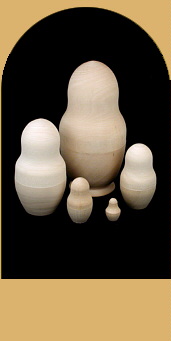How Matryoshka are
made
Russian Art History
Sharing Culture

|
The most popular of all the Russian Folk Arts is the Matryoshka (Nesting) Doll. Creating a Matryoshka is not an easy task. It requires the combined artistry of both woodworkers and artisans—two wholly different art forms! The dolls are traditionally fashioned from a single piece of linden or lime tree wood, or birch. These types of wood are naturally soft, which make them easily lathe turned. The trees chosen are typically cut down in the spring and stripped of their bark to prevent the wood from cracking when dried. The logs are kept in open air for years in order to dry completely. When ready, the logs are split into work pieces, with each piece passing through as many as 15 “turning” operations. The smallest doll is usually created first. From there, the bottom part of the next doll is begun, moving to the top. Once the proper height is reached. The piece is then cut in half, the rings to fit the doll together are formed, and both pieces are hollowed out. Then, the ascending dolls are made until the entire set is complete. Typical sets include 5, 7, or 10 pieces. After coating each doll with a starchy glue, the set is ready to hand over to artisans for painting or etching. Painting on a curved surface requires more skill than painting on a
traditional, flat surface. Authentic, hand-painted Matryoshka come in
six different mediums and four different finishes. Recently, an inauthentic
form of rendering the dolls has arisen from unscrupulous counterfeiters
who are silk-screening dolls. Authentic mediums include: Oil/Enamel
(the most common), Acrylic, Gouache, Watercolor, Wood-Burned, or a Combination
of these mediums. Finishes include Lightly Lacquered, Heavily Lacquered,
Waxed, and No Finish at all. Each medium and finish has advantages and
disadvantages in matters of appearance and protection. |
Return to Little Russia